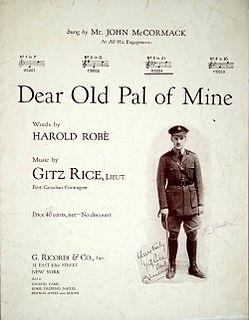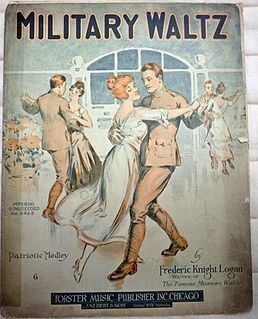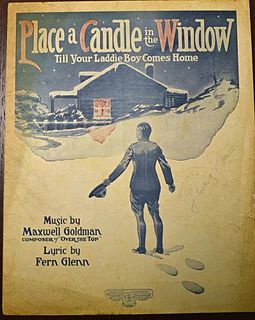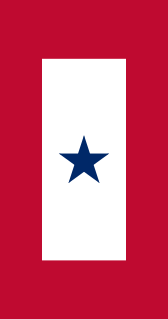
"Liberty Bell " is a song from 1917 written during World War I. Joe Goodwin wrote the lyrics, and Halsey K. Mohr wrote the music. The song was published by Shapiro, Bernstein & Co. in New York City.

There's a Red-Bordered Flag in the Window is a World War I era song released in 1918. Fred Ziemer wrote the lyrics. J.R. Shannon composed the music. The song was published by Vandersloot Music Publishing Company of Williamsport, Pennsylvania. On the cover, there is a red-bordered service flag with two blue stars. It hangs in front of a window. On each of the two stars is a picture of a mother and her son. The piece was written for both voice and piano. The song is directed at a mother of a soldier. It begins with, "Why are you sad little mother? Why do your eyes fill with tears?" Later the narrator encourages the mother to keep hope. The flag is seen as a symbol of pride and love, as evidenced by the chorus:

"I'm Goin' To Fight My Way Right Back to Carolina" is a World War I era song written and composed by Billy Baskette and Jessie Spiess. The song was published in 1918 by McCarthy & Fisher, Inc. of New York, New York. The sheet music cover was designed by Andre C. De Takacs. It features an armed soldier tearing through the cover. The song was written for both voice and piano.

Dear Old Pal of Mine is a World War I song written by Harold Robe and Gitz Rice. The song was first published in 1916 by G. Ricordi & Co. in New York, NY.

When the Clouds of War Roll By is a World War I song composed by Earl Haubrich with lyrics by Nat Binns. It was published in 1917 by Ted Browne Music Co. in Chicago, Illinois.
There's a Garden of Crosses in No Man's Land is a World War I song written by William Robinson and composed by Gus Wackrow. The song was published in 1918 by the Elite Publishing Company in Boston, MA.
Lafayette is a World War I song written and composed by Mary Earl, which was a pseudonymn of Robert A. King. It was published in New York, New York by Shapiro, Bernstein, & Co. in 1918. The sheet music cover, illustrated by Albert Barbelle, depicts soldiers marching with fixed bayonets below a statue of Lafayette in silhouette.
"Hock The Kaiser!" is a World War I song written and composed by James H. Hall in 1917. It targets the German emperor Wilhelm II of Germany. The work was self-published by James H. Hall in Chicago, Illinois.

"I'm Hitting The Trail to Normandy: So Kiss Me Goodbye" is a World War I song written and composed by Charles A. Snyder and Oscar Doctor. The song was published in 1917 by Snyder Music in New York, NY. The sheet music cover, illustrated by E.H. Pfeiffer, depicts a soldier kissing a woman good-bye with an inset photo of Paul Elwood.

"America's the Word for You and Me" is a World War I song written composed by Jacob J. Tanner Jr. The song was published in 1918 by Jacob J. Tanner Jr., in Pittsburgh, PA. The sheet music cover depicts a photo of President Wilson and the head of Uncle Sam with an inset of George Washington.

"If I Had A Son For Each Star In Old Glory " is a World War I song written by James E. Dempsey and composed by Joseph A. Burke. This song was published in 1917 by Leo. Feist, Inc., in New York, NY. The sheet music cover, illustrated by Rosenbaum Studios, features a mother looking at a picture of her son with an inset photo of Monte Austin. Other editions feature Brice and King; Buddy Clark; Ben Davis; and Florence Timponi.
"Give a Little Credit to the Navy" is a World War I song written by Buddy DeSylva & Gus Kahn and composed by Albert Gumble. This song was published in 1918 by Jerome H. Remick & Co., in Detroit, MI.
"America! My Home-Land" is a World War I song written by Henry Treleaven and composed by Richard Blaine. This song was published in 1917 by Boosey & Co. in New York, NY.

"Military Waltz" is a World War I song composed by Frederic Knight Logan. This song was published in 1917 by F.J.A. Forster, in Chicago Illinois. The sheet music cover features three soldiers dancing with women in a ballroom.
We Want Our Daddy Dear, Back Home is a World War I song written by James M. Reilly and composed by Harry DeCosta. The song was first published in 1918 by M. Witmark & Sons in New York, NY. The sheet music cover features a vitagraph photo of Aida Norton and a seated child.
We'll Carry The Star Spangled Banner Thru The Trenches is a World War I song written by Daisy May Pratt Erd. The song was first published in 1917 by Lang & Mendelsohn in Boston MA. The sheet music cover depicts soldiers advancing over barbed wire with a flag waving.

Place A Candle In the Window 'Till Your Laddie Boy Comes Home is a World War I song written by Fern Glenn and composed by Maxwell Goldman. The song was first published in 1918 by Buck & Lowney in New York, NY. The sheet music cover depicts a soldier returning to a snow covered house with a candle in the window.
Three wonderful Letters From Home is a World War I song written by Ballard MacDonald & Joe Goodwin and composed by James F. Hanley. The song was first published in 1918 by Shapiro, Bernstein & Co., in New York, NY. The sheet music cover depicts a mother, wife, and daughter writing letters with marching troops and a plane, ship, and tank in the background.
Welcome Home is a World War I song written by Bud Green and composed by Edward G. Nelson. The song was first published in 1918 by A.J. Stasny Music Co., in New York, NY. The sheet music cover depicts soldiers being welcomed home by men and women.
Mary F. Carty was a musician.












